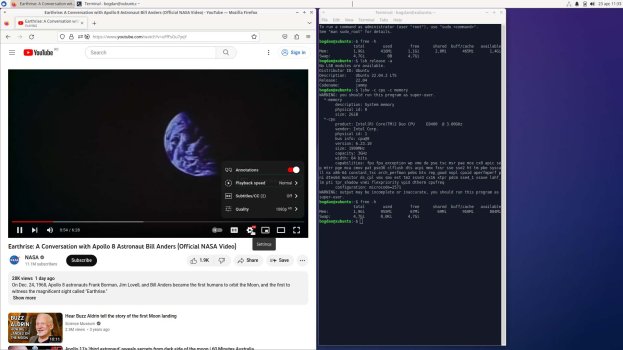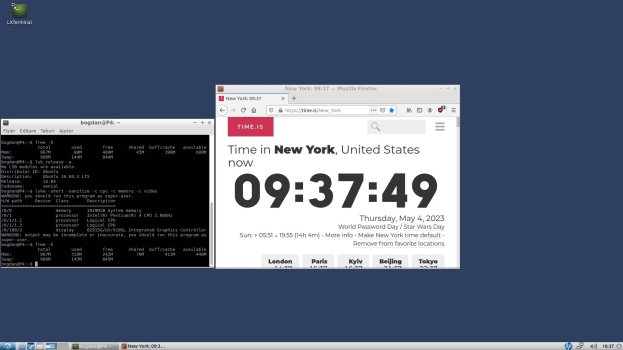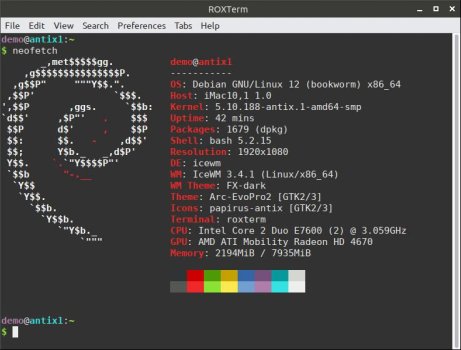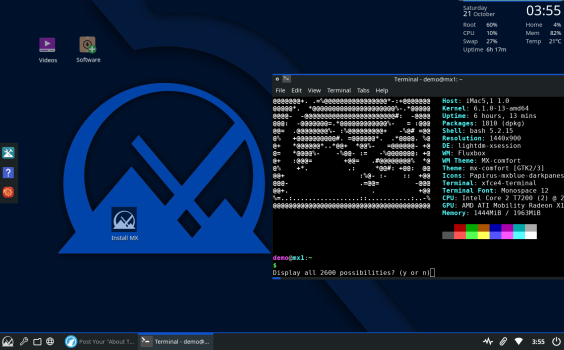Got a tip for us?
Let us know
Become a MacRumors Supporter for $50/year with no ads, ability to filter front page stories, and private forums.
Post Your "About This Linux/BSD" Screenshots...
- Thread starter S.B.G
- Start date
- Sort by reaction score
You are using an out of date browser. It may not display this or other websites correctly.
You should upgrade or use an alternative browser.
You should upgrade or use an alternative browser.
LOL ..so the slogan now is 'think different - use a PPC Mac with linux'
Wick..gonna look good on a t-shirt.
Void on a ZFS Root. It has a 13 year old budget laptop CPU and a very slow HDD.
But it is snappy and it uses less RAM than Xubuntu and Mageia + XFCE.
It is unbelievable that this kind of super recent kernel works so flawlessly on 13 year old hardware.
Last edited:
I’ve recently upgraded from Xubuntu 20 to Xubuntu 22.04.2 LTS on Intel Core2Duo E8400 2GB RAM

Related to this dead thread https://forums.macrumors.com/thread...on-of-linux-is-best-for-the-imac10-1.2387283/

Related to this dead thread https://forums.macrumors.com/thread...on-of-linux-is-best-for-the-imac10-1.2387283/
Void Linux + XFCE uses 365MB of RAM right after login according to neofetch. According to the same app (neofetch), Xubuntu uses more than 460MB of RAM. You should always use the same app to compare RAM usage because apps usually calculate it in a slightly different way.I’ve recently upgraded from Xubuntu 20 to Xubuntu 22.04.2 LTS on Intel Core2Duo E8400 2GB RAM
View attachment 2196915
Related to this dead thread https://forums.macrumors.com/thread...on-of-linux-is-best-for-the-imac10-1.2387283/
Void Linux also has the fastest package manager:
Of course, runit from Void is also much faster than the slow systemd implementation of Xubuntu and other Ubuntu variants, so you can say that Ubuntu variants are the worst choices for older systems. It's best to choose systems like Devuan, Void, FreeBSD, MX Linux, Artix Linux, and mageia for older systems, because Ubuntu is super slow in all domains on older systems.
The first RAM read is with just Terminal open - 416M. The second one is with Firefox playing a 1080p YouTube video – 955M.
I really don’t care what influencers are lamenting about on YouTube. I’ll keep using Xubuntu or whatever I like at the moment.
I really don’t care what influencers are lamenting about on YouTube. I’ll keep using Xubuntu or whatever I like at the moment.
You use the free -h command. What I'm trying to convey to you is that different commands to measure the RAM lead to different results. So there is no consensus on what is the correct methodology to measure RAM usage. You can try the three methods below.The first RAM read is with just Terminal open - 416M. The second one is with Firefox playing a 1080p YouTube video – 955M.
Keene Enterprises :: Open Source :: Freecolor
GitHub - brndnmtthws/conky: Light-weight system monitor for X, Wayland, and other things, too
Light-weight system monitor for X, Wayland, and other things, too - brndnmtthws/conky
GitHub - htop-dev/htop: htop - an interactive process viewer
htop - an interactive process viewer. Contribute to htop-dev/htop development by creating an account on GitHub.
What you're going to see is that these three will give significantly different results at any given time. If you want to compare your RAM usage with my result you should use neofetch instead of free -h.
Of course you can use whatever you want, but I'm just saying that Ubuntu is objectively one of the worst Linux systems for older (weak) hardware. I have also given three different reasons:
1. Ubuntu's package manager is one of the slowest around, much slower than XBPS and pacman.
2. Ubuntu's systemd boot init is much slower than what you'll see in systems that don't use systemd like eg Devuan, Artix Linux, Void Linux, MX Linux.
3. Ubuntu has the vision that Snaps should become the standard for their system. Snaps the slowest solution currently in existence when compared to alternatives such as AppImage, Flatpak and Nix. The installation of snaps is very slow and opening the apps is also very slow every time with the heavier apps.
If you're going to use old hardware it's still going to be a bit slower, even if you're using the fastest Linux distros. So if you use Ubuntu on old hardware you will find yourself losing time all the time, the more you use Ubuntu on old hardware the more time you lose. Maybe you hardly ever use it and then it doesn't really matter. But if you use it frequently, you simply lose a lot of time.
This is 2012 MBA 1.8GHz (turboboost 2.8GHz as shown above). Geekbench 5 and Neofetch lists core clocks for MaOS -machines but Turbo clocks for Linux-machines which is a bit confusing. MBA single core performance is better than cMP 5.1 with X7660 running Linux, cMP is even slower with MacOS.
Attachments
Last edited:
And another one. MacBook Pro 17" A1297 2010. Doubleboot with MacOS. Mint works nicely on this one too.

Finally found the courage/time to install Void on my Zbox CI323:

I am more familiar with [Gen|Fu]ntoo, so this has been a Definite Experience
An educational test-case run in preparation for getting OPNSense onto an uSFF x86...
...successfully updated to 16GB of RAM on a Braswell platform {coup}, but not really satisfied with the performance of the Realtek NICs {bummer} ;(
Still, Void is a Classy OS <smile>
I am more familiar with [Gen|Fu]ntoo, so this has been a Definite Experience
An educational test-case run in preparation for getting OPNSense onto an uSFF x86...
...successfully updated to 16GB of RAM on a Braswell platform {coup}, but not really satisfied with the performance of the Realtek NICs {bummer} ;(
Still, Void is a Classy OS <smile>
Found MX with the Flux box window manager works better 'out of the box' for the 17 inch iMac than the xfwm4 such as seems zippier, easier to resize windows and smaller download (no LibreOffice but can be added if you need it.) But also found a Conky that has a working temperature reading.. ok - so not the GPU as Id like..but may have some pointers to get that .
Attachments
Register on MacRumors! This sidebar will go away, and you'll see fewer ads.








